The Best Applications of AI in Edge Computing for Real-World Solutions
Edge computing is a distributed computing paradigm that shifts data processing and storage closer to the edge devices — such as IoT sensors, cameras, and gateways — instead of relying solely on centralized cloud computing facilities or cloud data centers.
This approach provides three key advantages over cloud computing:
Reduced latency: By processing sensor data directly at the network edge, systems deliver real time data processing and responsiveness.
Optimized bandwidth: Only relevant or compressed data is transmitted to cloud servers or edge servers, reducing costs.
Improved resilience: Applications continue functioning without interruption even if internet connection to a centralized cloud is unstable.
As IoT adoption accelerates, the volume of data generated by billions of connected devices continues to grow exponentially. Centralized cloud data centers cannot always process this information quickly enough. This is why AI in edge computing — often called AI at the edge — is emerging as a game-changer.
Edge AI enables artificial intelligence (AI) models to be executed locally, supporting real time decision making in areas such as predictive maintenance, industrial automation, smart cities, and autonomous vehicles. In fact, many analysts consider ai and edge computing to be the foundation of the intelligent edge, which is poised to impact society as significantly as the rise of cloud computing did a decade ago.
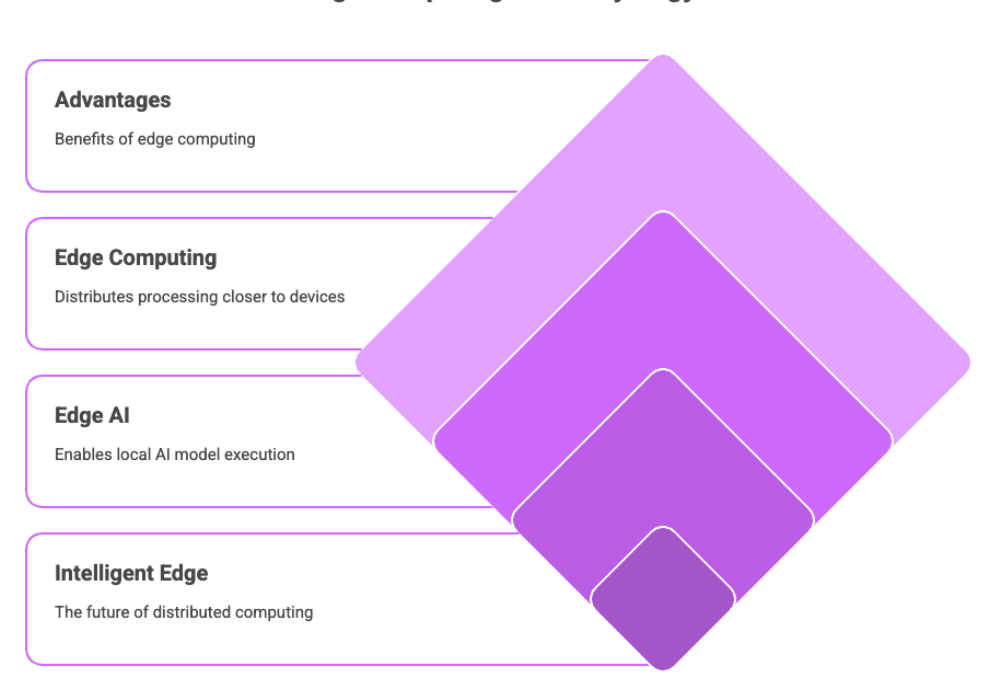

Benefits and Advantages of Edge AI
The benefits of edge AI go beyond speed. Organizations deploying edge artificial intelligence gain operational, financial, and regulatory advantages:
Reduced latency & real time responsiveness
By processing data directly on local edge devices, edge AI technology minimizes the milliseconds lost when sending information to the cloud.
Critical for safety in autonomous vehicles, industrial robotics, and healthcare monitoring systems.
Enhanced privacy & security
Sensitive workloads, such as financial transactions or healthcare sensitive data, remain on-device instead of being transmitted to cloud servers.
This approach reduces exposure to cyber threats and ensures compliance with GDPR, HIPAA, and industry-specific regulations.
Cost efficiency & bandwidth optimization
With less data transmission required, companies cut costs on internet bandwidth and centralized storage.
Many edge deployments only send relevant information or aggregated insights to the cloud.
Operational efficiency & predictive maintenance
Factories leverage edge AI models for quality control, detecting defects instantly through computer vision.
Predictive analytics powered by machine learning algorithms help anticipate equipment failures, saving both time and money.
Scalable, secure platforms
Edge AI platforms simplify deploying and managing AI applications at scale.
They include tools for monitoring AI models, securing edge locations, and enabling updates across thousands of IoT devices.
With these benefits, edge AI offers organizations a chance to accelerate innovation while protecting data integrity.
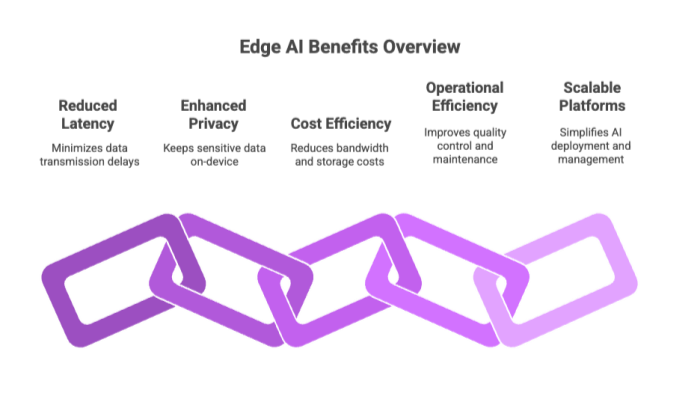

Edge AI Technology
At its core, edge AI technology fuses AI models with edge computing to deliver intelligence locally.
Key Components of Edge AI Technology
AI algorithms & machine learning models: These power real-time inference at the network edge. They range from simple anomaly detection to deep learning networks for object detection or natural language processing.
Edge devices & hardware accelerators: From smart cameras to smart home appliances, modern edge servers integrate inference engines and AI accelerators to handle workloads efficiently.
Edge AI platforms: Provide AI services for deploying edge AI, updating AI models, and monitoring performance. Examples include NVIDIA Jetson, Intel OpenVINO, and AWS IoT Greengrass.
Multi-access edge computing (MEC): Extends edge technology within 5G networks, allowing AI at the edge to deliver low latency services for industries such as telecommunications and smart cities.
Feedback loops: While data processing happens locally, edge AI work often involves sending data back to the central server for retraining. Updated AI models are then redeployed, enabling systems to continuously improve.
AI Technology in Action
Computer vision applications: Detect objects, perform quality control, or enhance safety through security cameras.
Supply chain analytics: Predict demand fluctuations by analyzing big data streams from logistics systems.
Smart devices & smart home devices: Automate energy usage, manage appliances, and improve consumer experiences with real time insights.
The future of edge AI capabilities lies in making AI applications more autonomous, efficient, and adaptable to diverse environments — from industrial robots to personal wearable devices.
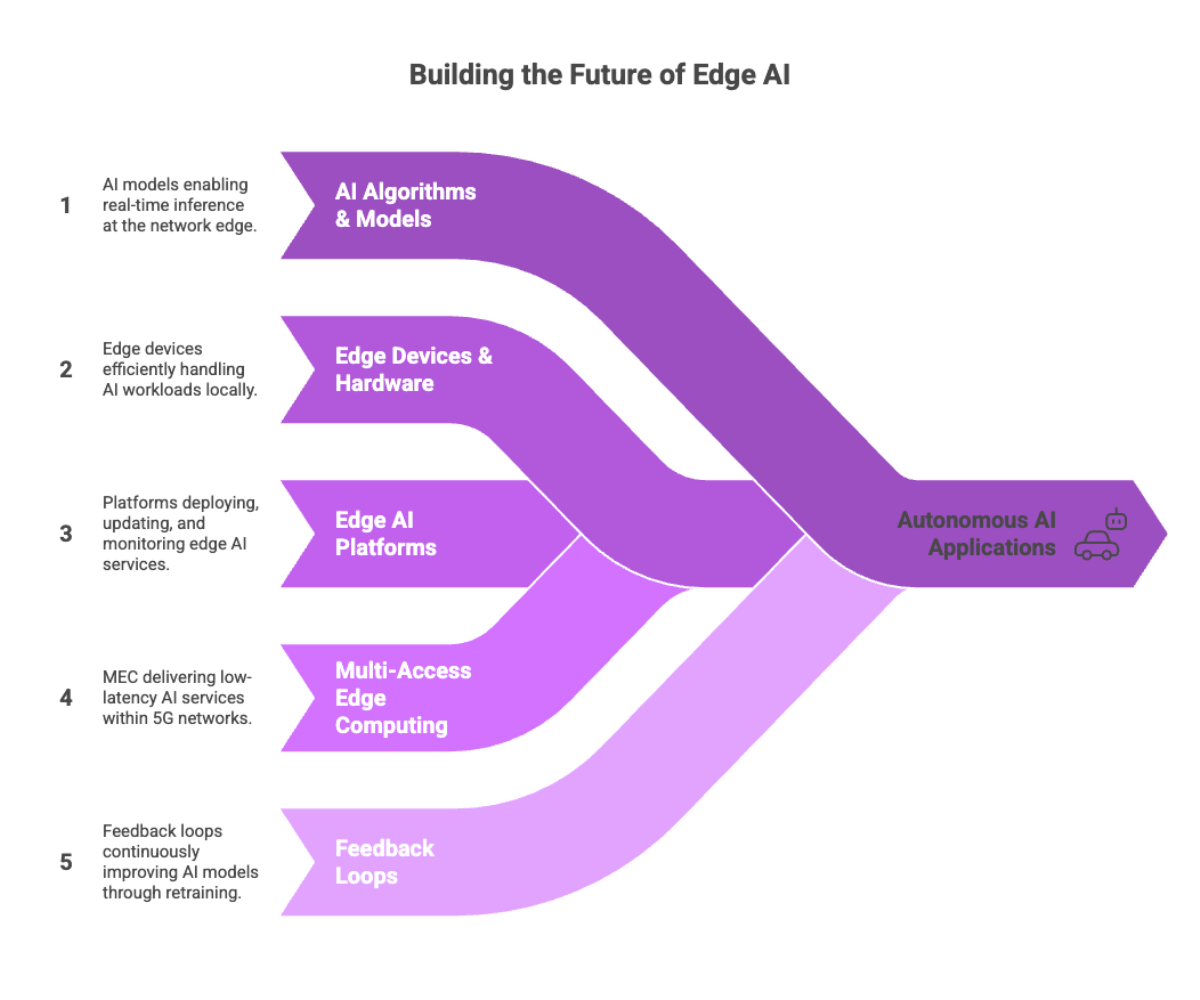

Deployment and Implementation of Edge AI
Deploying AI in edge computing requires balancing edge devices, edge servers, and cloud services to achieve the right mix of scalability, real time data processing, and security.
Key Factors for Deployment
Choice of hardware
Edge devices range from low-power IoT devices (smart thermostats, cameras, sensors) to high-performance edge servers supporting multi-access edge computing.
Specialized AI hardware, such as GPUs, TPUs, and NPUs, accelerates AI models and ai algorithms locally.
Software frameworks & edge AI platforms
Platforms like NVIDIA Jetson, Google Edge TPU, or Microsoft Azure IoT Edge provide the tools needed for deploying edge AI efficiently.
They also support monitoring, updating, and retraining edge AI models via a feedback loop with the cloud.
AI models & optimization
Lightweight machine learning algorithms and deep learning architectures are often optimized for processing data directly on devices with limited computing power.
Techniques like quantization, pruning, and inference engines ensure faster performance on resource-constrained devices.
Data science expertise
Successful deployment requires data scientists and engineers to design workflows that balance local autonomy with centralized intelligence.
This ensures AI applications remain reliable while continuously improving with new data collected from the field.
Security and compliance
With large amounts of sensitive data processed locally, encryption, secure boot, and trusted execution environments are crucial.
Regulatory frameworks demand that edge AI solutions comply with GDPR, HIPAA, and other regional privacy laws.
The implementation of edge AI is not simply a technical decision but a business one — organizations must align deployment with goals like cost savings, operational efficiency, and faster innovation.
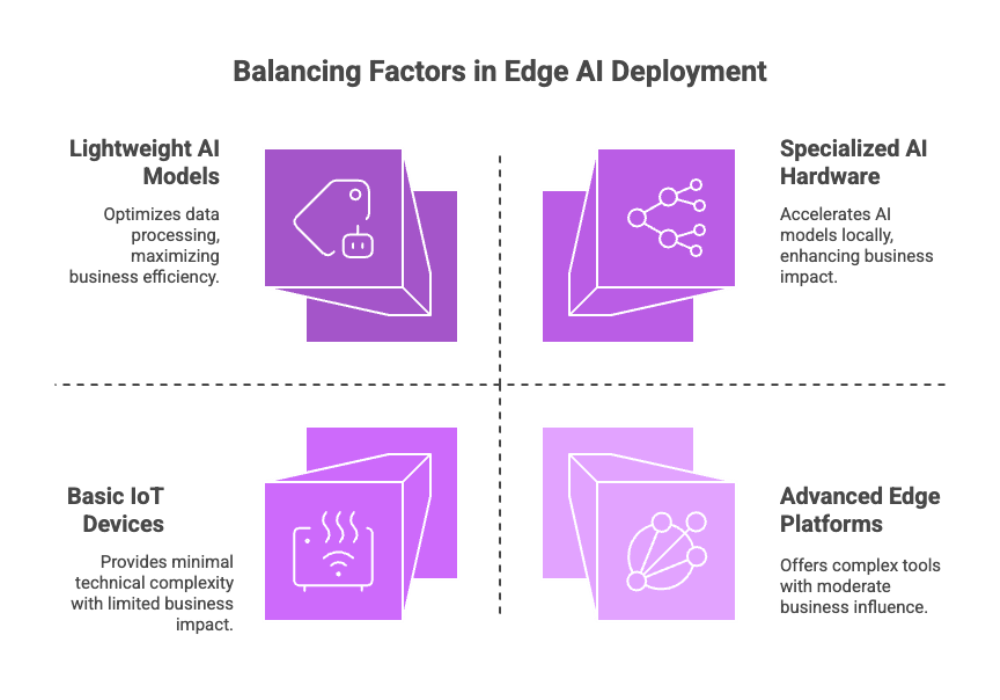

Real-World Applications of Edge AI
The most exciting aspect of edge AI is how it is transforming industries with real-world applications that demand real time decision making and reliability.
1. Industrial Automation
Predictive maintenance: Edge AI technology analyzes sensor data from machinery to predict failures before they occur.
Quality control: Cameras powered by computer vision detect defects in products instantly.
Autonomous operations: Factories are evolving toward self-optimizing production lines with minimal human intervention.
Supply chain analytics: AI at the edge supports real-time inventory and logistics optimization.
2. Smart Cities
Traffic control systems: AI-driven analysis of data generated by roadside cameras and sensors enables congestion management and reduces accidents.
Energy optimization: Smart grids use edge AI models for demand forecasting and load balancing.
Public safety: Security cameras combined with edge artificial intelligence detect suspicious activity without sending video streams to a centralized data center.
3. Healthcare
Remote monitoring: Smart devices such as wearable health trackers process data locally, enabling continuous monitoring even without internet connectivity.
Predictive analytics: AI detects anomalies in patient vitals, triggering alerts in near real time.
Patient privacy: Processing sensitive data at the network edge reduces compliance risks while ensuring faster diagnostics.
4. Autonomous Vehicles
Self-driving cars depend heavily on edge AI capabilities for real time data processing from LIDAR, radar, and cameras.
Object detection and path planning occur instantly on-vehicle, ensuring safety and reducing reliance on cloud servers.
Autonomous decision-making: Vehicles can react within milliseconds, a feat impossible with cloud-only models.
5. Smart Homes & Consumer IoT
Smart home appliances use edge AI solutions for voice recognition, predictive energy optimization, and real time insights for homeowners.
Security cameras and smart cameras run AI inference engines locally to detect motion, faces, or anomalies.
Smart checkouts in retail leverage edge devices for object detection and faster customer experiences.
6. Data Centers & Cloud Efficiency
Data centers use edge AI technology for cooling optimization, workload balancing, and energy reduction.
AI-powered systems analyze data collected by sensors, delivering smarter infrastructure management.
With cloud infrastructure increasingly hybridized, edge AI offers a complementary layer of efficiency.
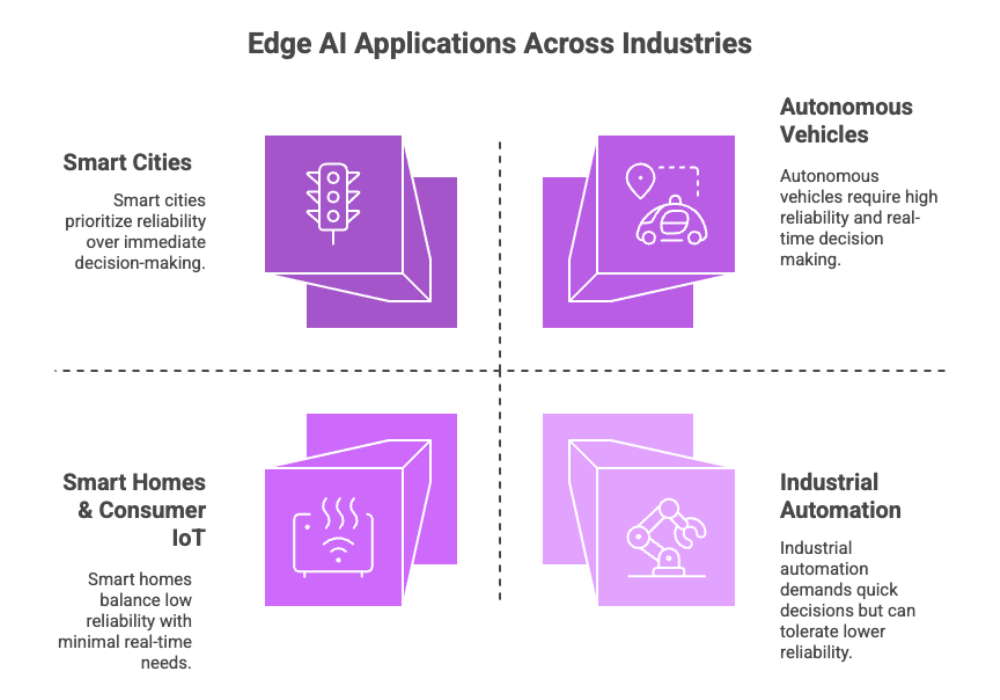
The Future of AI in Edge Computing
The integration of AI in edge computing is rapidly evolving, with multiple trends shaping the future:
Multi-Access Edge Computing (MEC)
Telecom operators are embedding edge servers into 5G networks to support real time decision making for applications like autonomous vehicles and smart manufacturing.
MEC enables ultra-low latency and brings AI workloads closer to edge locations where data is generated.
AI Accelerators at the Edge
Next-generation chips, such as NPUs and TPUs, are designed to handle machine learning models and ai algorithms efficiently on small devices.
This reduces reliance on cloud computing facilities and improves processing data directly at the edge.
Distributed AI at Scale
Organizations are adopting distributed AI to coordinate intelligence across thousands of connected devices.
This allows local data processing while sharing aggregated insights with centralized cloud infrastructure.
AI-as-a-Service at the Edge
Businesses can subscribe to edge AI platforms for scalable AI without investing heavily in specialized hardware.
This model lowers entry barriers for industries deploying ai applications such as predictive maintenance and supply chain analytics.
Focus on Energy Efficiency
With billions of IoT devices generating data, low power computing solutions will be critical.
Edge AI frameworks are increasingly optimized for scalable storage, bandwidth optimization, and energy-aware AI execution.


Business Impact of Edge AI Solutions
The benefits of edge AI are not just technological — they directly influence business models, operational efficiency, and cost savings.
Improved decision-making
Edge AI empowers industries to collect data, process data, and generate key insights in real time, improving responsiveness.
Data security and compliance
By processing sensitive data on local edge devices, industries reduce reliance on external servers and strengthen data sovereignty.
Reduced operational costs
Eliminating unnecessary data transmission to cloud servers lowers bandwidth expenses, while predictive maintenance reduces downtime.
New revenue streams
Companies can monetize real time insights and deliver AI at the edge services to customers, reshaping industries through agentic AI and data-driven ecosystems.
Reshaping industries
From autonomous vehicles and smart cities to industrial edge operations, the use of edge artificial intelligence is creating smarter, safer, and more connected ecosystems.
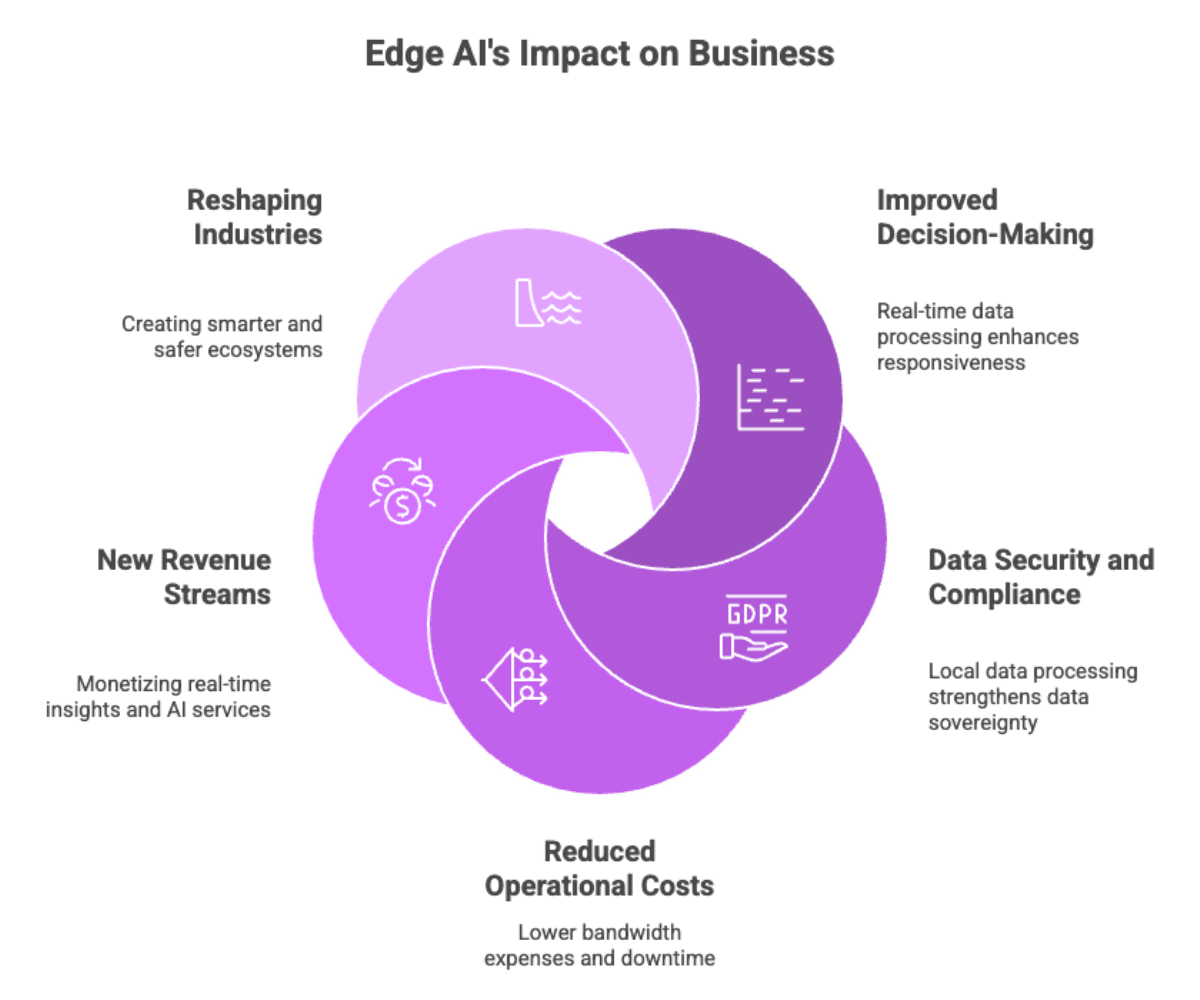

Conclusion: Edge AI Driving the Future
The combination of AI and edge computing is reshaping how data is processed, secured, and applied in real-world scenarios.
Edge AI solutions reduce latency, enable real time data processing, and enhance security by keeping data locally on edge devices.
Businesses leveraging enterprise edge platforms and ai solutions gain a competitive advantage through faster insights, cost savings, and enhanced privacy.
The future lies in hybrid architectures — where cloud AI powers training and aggregation, while edge AI models execute real time analysis at the network edge.
As industries embrace distributed AI and edge AI technology, we are entering an era where decision-making becomes autonomous, data-driven, and nearly instantaneous.
In summary: Edge AI is no longer optional — it is becoming the foundation of modern AI applications, enabling organizations to innovate faster, optimize operations, and create smarter ecosystems across industries.


